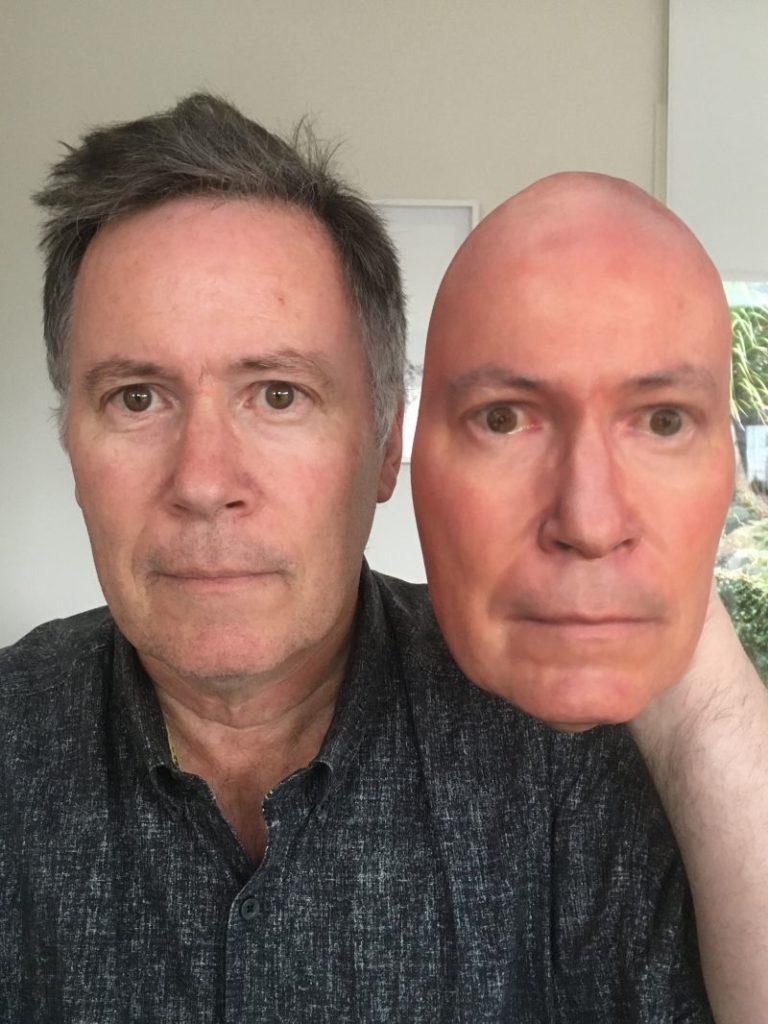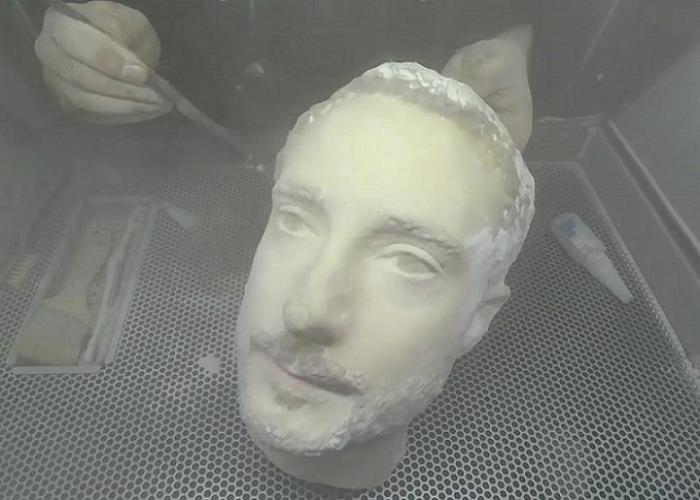
Olaf Diegel, Professor of Additive Manufacturing at the University of Auckland, is well known for his 3D printed guitars. He and his students conduct many more experiments and projects, however. Recently he used a Mimaki 3DUJ-553 3D printer and a 3D scan to make a copy of his face to see if he could fool facial recognition. The $180,000 machine printed the face and two other models in 11 hours in acrylic using the standard quality mode, including 32-micron layer thickness.
Subsequently, Diegel, and his team then “scraped off most of the soluble wax support material by hand, and then put it in the ultrasonic cleaning bath for about an hour, then rinsed it off with cold water while brushing it with a stiff brush (to remove any last bits of support material) and, finally, wiping it with isopropyl alcohol. Then I gave it about 3 or 4 coats of very matt clearcoat (45% matt), and hand painted the eyes with a gloss clearcoat to make them sparkle a bit.”
This seems to be quite an accessible task and the resulting 3D printed face is remarkable. The investment for such a machine is also foreseeable, as would be the part cost. You could order a face replica from a 3D print service, as well. This has some profound implications that we should address. People have been publicly playing around trying to fool facial recognition for years now. Cybersecurity firm BKAV tricked the iPhone X FaceID with a 3D printed mask in 2017, and made a better mask later on, while others have fooled Android face scanning. Artist Sterling Crispin made 3D printed datamasks which obscure your face from surveillance by the government and social media picture snappers.
One of Sterling Crispen’s data masks.
Facial recognition is a burgeoning field.We use it to unlock our phones, as well as to make purchases using the same device. Facial recognition is also relied on for access control to buildings and sensitive installations. Casinos and retail chains take security images of shoplifters and casino cheats, continuously scanning crowds for them. Police can facial recognition to quickly identify suspects or victims. Your photo is compared to biometric data in your passport to gain access to countries. Facebook uses it to determine who is in your photos, In China, Ant Financial will spend over $400 million trying to convince people to use facial recognition for payments and schools use it to track attendance.
Apparently, “In China, toilet paper theft in public restrooms is a big problem. Luckily face recognition has come to the rescue. China has installed machines in public restrooms that scan people’s faces before releasing toilet paper. It won’t release more paper to the same person until after 9 minutes have gone by.”

China is a huge user of facial recognition for security, as well. Shanghai has 113 cameras for every 1,000 people, and the country has facial recognition files for all of its citizens. Counting those from commercial companies, the country has 200,000 million cameras. Megvii Technology, SenseTime and YITU are facial recognition startups that use AI and have received $1.4 billion, $2.6 billion, and $400 million respectively. Facial recognition is key to China’s plans for maintaining order in their country and beyond.
One journalist stated that, “What the Communist Party is doing with all this high-tech surveillance technology now is they’re trying to internalize control… Once you believe it’s true, it’s like you don’t even need the policemen at the corner anymore because you’re becoming your own policeman.”
The utopian view of this would be that facial recognition is a ubiquitous technology, running in the background of every social interaction and each of our moments and that it promotes good behavior and safety. A more negative view would be that Orwell was quite prescient indeed. While another view maintained by comedian Keith Lowell Jensen is: “What Orwell failed to predict is that we’d buy the cameras ourselves, and that our biggest fear would be that nobody was watching.”
So, if we take these views and combine them, we discover that the Orwellian surveillance state is probably a lot smarter and efficient than the one Orwell dreamed up, while Aldous Huxley‘s view that we’d sink into a morass of self-absorption is also correct, only the drugs are many not one.
Zcorp 3D print used to fool Android facial recognition.
We are seeing a collision course emerging that will affect our industry. Our cute little technology may just be a key for weakening a surveillance state, carrying out sophisticated crimes, fraud, terrorism, and regaining liberties in the future. 3D scanning and 3D printing are the easiest technologies to capture and replicate 3D surfaces, such as faces. Our technology could be used in the future to create veins and pores and other markers, as well as cornea. We can thank to Mimaki to do millions of colors and 3D printing could do capture textures, too. Our technology can evolve quickly and, like no other, we can iterate and improve to meet new challenges. At the core of our technology is the ability to quickly create new shapes. And this is exactly what you would need to do in order to continually outfox a surveillance state, for noble or criminal reasons.
As an industry, we need to be prepared for this. Do we take up the pen argument? You can write beautiful poems and hate speech with a pen. It is not our job to regulate what our customers do with it. Sadly, lawmakers have been quick to develop new laws specifically aimed at 3D printing in the past. Do we build in a security feature that would put a telltale sign on every print letting scanners know that it is an artificial copy? What would that mean for us? Do we take sides? As an industry, do we commit to quashing this? Or do we encourage a free exploration of this technology, since, after all, every technology—even a fork—can be dangerous? This is something that we shall need to think about because our technology, inventively and inevitably, will be used for evil and good to disrupt both evil and good.
Stay up-to-date on all the latest news from the 3D printing industry and recieve information and offers from thrid party vendors.
Tagged with: 3D printed acrylic • 3d printed masks • 3d scan • 3d scanning • face • facial recognition • hacking • masks • Mimaki • Mimaki 3DUJ-553 3D printer • scanPlease enable JavaScript to view the comments powered by Disqus.